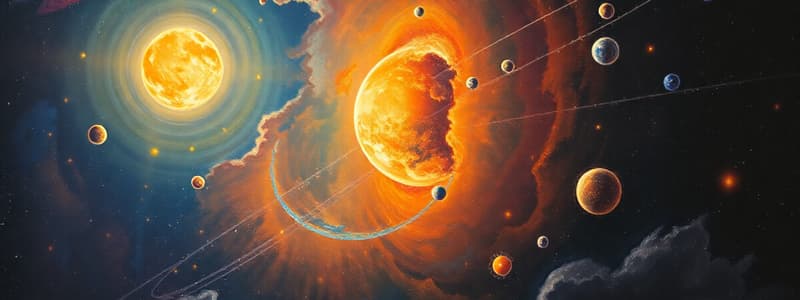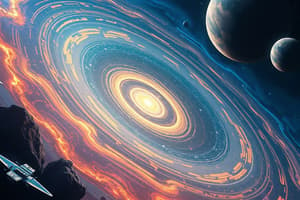Podcast
Questions and Answers
What is the primary component of the nebula from which the solar system is believed to have formed?
What is the primary component of the nebula from which the solar system is believed to have formed?
What is the phenomenon responsible for the flattening of the nebula into a disk shape?
What is the phenomenon responsible for the flattening of the nebula into a disk shape?
What is the name given to the extremely dense and hot central region of the spinning disk?
What is the name given to the extremely dense and hot central region of the spinning disk?
How did planetesimals form?
How did planetesimals form?
Signup and view all the answers
Which of the following processes led to the formation of the planets?
Which of the following processes led to the formation of the planets?
Signup and view all the answers
What is one of the objections raised against the nebular hypothesis concerning the planet's rotation?
What is one of the objections raised against the nebular hypothesis concerning the planet's rotation?
Signup and view all the answers
What is another objection raised against the nebular hypothesis regarding the origin of heavy elements on Earth?
What is another objection raised against the nebular hypothesis regarding the origin of heavy elements on Earth?
Signup and view all the answers
What is an observation that challenges the nebular hypothesis regarding the orbits of some satellites?
What is an observation that challenges the nebular hypothesis regarding the orbits of some satellites?
Signup and view all the answers
Study Notes
Nebular Hypothesis
- Proposed by Immanuel Kant and Pierre-Simon Laplace in the 18th century
- A scientific theory explaining the formation of the solar system
- Suggests that the Sun, planets, and other celestial bodies formed from a rotating cloud of gas and dust called a nebula
- This nebula collapsed under its own gravity
- The collapse caused the nebula to spin faster and flatten into a spinning disk- shape
- The central region of this disk (the protosun) became increasingly dense and hot
- This resulted in nuclear fusion, creating the Sun
- The remaining material in the disk consisted of gas, dust, and solid particles (planetesimals)
- These planetesimals collided and merged through a process called accretion, gradually growing in size
- This formed larger bodies called protoplanets
- Protoplanets underwent differentiation
- Denser materials sank to the core, while lighter materials formed the mantle and crust
- This process generated heat, leading to a molten interior of some planets
- The theory is not without objections
Objections to the Nebular Hypothesis
- Planets hold 98% of the solar system's rotational energy, while the Sun holds 99.87% of the mass
- Heavy elements in Earth can only form at temperatures significantly higher than those on the Sun
- Some satellites rotate in a backward (retrograde) direction, and their speeds can exceed the rotation speed of their planets.
Studying That Suits You
Use AI to generate personalized quizzes and flashcards to suit your learning preferences.
Related Documents
Description
Explore the Nebular Hypothesis proposed by Kant and Laplace, detailing how our solar system formed from a rotating cloud of gas and dust. Understand the processes involved in the collapse of the nebula, the formation of the Sun, and the creation of planets through accretion and differentiation.




